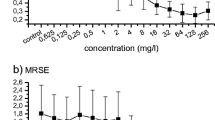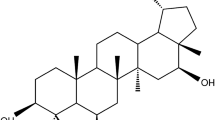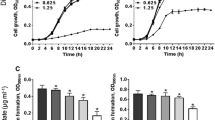Abstract
Antimicrobial resistance in bacteria, such as Staphylococcus aureus, has been the subject of many assistance studies of alternatives for the treatment of infections. These studies aim to solve this problem for bacteria, such as biofilm formation. Aiming to control the emergence of the problem or enhance antibiotic activity, the data sources are inserted into new therapeutic alternatives for the treatment of infections. β-Lapachone and Lapachol Oxime are semi-synthetic derivatives of Lapachol with antimicrobial potential. Clinical isolates from human blood cultures were used in this study. Scanning electron microscopy (SEM) was performed following the glutaraldehyde fixation protocol. The presence of β-Lapachone and Lapachol Oxima interfered in the biofilm formation state. In the MEV, the effect was observed in the reduction of the population of biofilm-forming cells. Therefore, it was possible to conclude the promising potential of the anti-biofilm of substances, justifying the nature of the natural products as agents of inspiration for the detection of new compounds with the biological function.


Similar content being viewed by others
References
Archer NK et al (2011) Staphylococcus aureus biofilms. Virulence 2(5):445–459
Kong KF et al (2006) Staphylococcus quorum sensing in biofilm formation and infection. Int J Med Microbiol 296:133–139
López D, Vlamakis H, Kolter R (2010) Biofilms. Cold Spring Harb Perspect Biol 2(7):1–11
Ribeiro SM et al (2016) New frontiers for anti-biofilm drug development. Pharmacol Ther 160:133–144
Paharik AE, Horswill AR (2016) The staphylococcal biofilm: adhesins, regulation, and host response. Microbiol Spectr 4:529–566. https://doi.org/10.1128/microbiolspec.VMBF-0022-2015
Cragg GM, Newman DJ (2013) Natural products: a continuing source of novel drug leads. Biochim Biophys Acta 1830:3670–3695
Cos P et al (2006) Anti-infective potential of natural products: how to develop a stronger in vitro ‘proof-of-concept’. J Ethnopharmacol 106:290–302
Taylor PW (2013) Alternative natural sources for a new generation of antibacterial. Int J Antibact Agents 42:195–201
Araújo EL et al (2002) Lapachol: segurança e eficácia na terapêutica. Rev Bras Farmacogn. 12:57–59
Fonseca SGC, Braga RMC, Santana DP (2003) Lapachol—química, farmacologia e métodos de dosagem. Rev Bras Farm 84(1):9–16
Merino N et al (2009) Protein a-mediated multicellular behavior in Staphylococcus aureus. J Bacteriol 191(23):832–843
CLSI (2014) Methods for dilution antimicrobial susceptibility tests for bacteria that grow aerobically; approved standard-ninth edition. CLSI document M07-A9. Clinical and Laboratory Standards Institute, Wayne
Nostro A et al (2007) Effects of oregano, carvacrol and thymol on Staphylococcus aureus and Staphylococcus epidermidis biofilms. J Med Microbiol 56:519–523
Freitas VR, Sand STVD, Simonetti AB (2010) Formação in vitro de biofilme por Pseudomonas aeruginosa e Sthaphylococcus aureus na superficie de canetas odontológicas de alta rotação. Rev. Odontol UNESP 39(4):193–200
Araújo CRM et al (2014) Síntese e determinação in vitro do FPS-UVB de oximas derivadas do lapachol. Rev Virtual de Química 6:1702–1712. https://doi.org/10.5935/1984-6835.20140110
Różalski MI et al (2013) Antimicrobial/anti-bioflm activity of expired blood platelets and their released products. Postepy Hig Med Dosw (online) 67:321–325
Otto M (2008) Staphylococcal biofilms. Curr Top Microbiol Immunol 322:207–228
Tretin DS et al (2011) Potential of medicinal plants from the Brazilian semi-arid region (Caatinga) against Staphylococcus epidermidis planktonic and biofilm lifestyles. J Ethnopharmacol 137:327–335
Arciola CR et al (2015) Polysaccharide intercellular adhesin in biofilm: structural and regulatory aspects. Front Cell Infect Microbiol 5:1–7
Büttner H, Mack D, Rohde H (2015) Structural basis of Staphylococcus epidermidis biofilm formation: mechanisms and molecular interactions. Front Cell Infect Microbiol 5(14):1–15. https://doi.org/10.3389/fcimb.2015.00014
Gotz F (2002) Staphylococcus and biofilms. Mol Microbiol 43(6):1367–1378
Mack D et al (2004) Mechanisms of biofilm formation in Staphylococcus epidermidis and Staphylococcus aureus: functional molecules, regulatory circuits, and adaptive responses. Int J Med Microbiol 294:203–212
Hertiani T et al (2010) From anti-fouling to biofilm inhibition: new cytotoxic secondary metabolites from two Indonesian Agelas sponges. Bioorg Med Chem 18:1297–131
Acknowledgements
To CAPES (Higher Education Personnel Improvement Coordination) and FACEPE (Foundation for Science and Technology of Pernambuco) by granting the scholarship and research, aiming to stimulate the formation of high-level resources and standards of excellence indispensable to the development of our country.
Author information
Authors and Affiliations
Corresponding author
Additional information
Publisher's Note
Springer Nature remains neutral with regard to jurisdictional claims in published maps and institutional affiliations.
Rights and permissions
About this article
Cite this article
Fernandes, A.W.C., dos Anjos Santos, V.L., Araújo, C.R.M. et al. Anti-biofilm Effect of β-Lapachone and Lapachol Oxime Against Isolates of Staphylococcus aureus. Curr Microbiol 77, 204–209 (2020). https://doi.org/10.1007/s00284-019-01818-1
Received:
Accepted:
Published:
Issue Date:
DOI: https://doi.org/10.1007/s00284-019-01818-1




